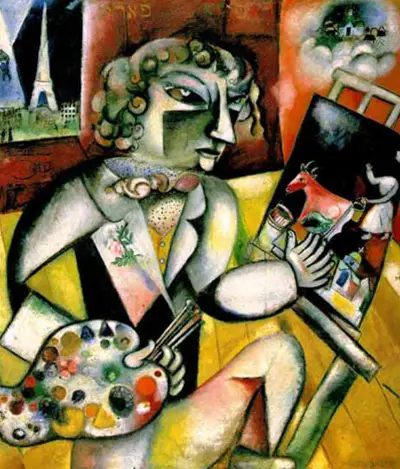It is considered to be one of his best-known works that he painted during his time in Paris in his first studio. Looking at the different objects in the painting they appear as broken, almost puzzle-like shapes.
The picture represents his experimentation with Cubism where he has broken up reality and put it back together in new ways.
The painting is not a self-portrait that is true to life. However, even with its cubist style, the picture tells us much about Chagall as both a person and artist.
The picture dates from sometime after he moved from Russia to Paris. His love of Paris comes through in the picture. This is visible in his inclusion of the Eiffel tower as a feature in a window that is in the top left-hand corner of the painting.
In the self-portrait, Chagall is painting at his easel what appears to be a milkmaid and cow. Above his head is a cloud and within it is depicted his hometown of Vitebsk. Also at the top of the canvas are the words ‘Paris’ and ‘Russia’ written in Hebrew.
Despite the cubist style, Chagall appears to have captured some of his features in the portrait – the long straight nose, almond-shaped eyes and the curly mane of hair.
Although it was the style at the time, he is shown wearing a 3-piece suit. Another distinctive feature of the painting is that Chagall portrays himself with seven fingers on each of his hands.
In much of his work, it is Chagall’s Jewish heritage that shows through strongly. It shows itself through references to old folktales, fables and beliefs. In painting, Self-portrait with Seven Fingers, Chagall has drawn upon the Yiddish folk expression about doing something with seven fingers.
One interpretation of the meaning of the phrase is about doing something well or nimbly. An alternative definition for the seven fingers on his hand may be the result of his birth date being the seventh day of the seventh month in 1887.
Although a self-portrait, the painting shows Chagall’s Jewish heritage and his love of Paris. It also connects the artist to his hometown and his link with Russia. His falling between the two worlds of his birth and his geographic location is perhaps an indication of the writing of the words 'Paris' and 'Russia' in Hebrew.
Born in 1887 in Vitebsk, Russia (now Belarus) Marc Chagall was a twentieth century Russian/French painter. One of nine children, born into a devoutly Jewish family, Chagall was a painter, printmaker and designer during his long career. The many works he created cover nearly all artistic formats. An early modernist painter, he also used several other artistic styles during his lifetime, one of those being Cubism.
Many saw Chagall as the twentieth century’s typical Jewish artist. One of his best-known works in which he experiments with the Cubist style is Self-Portrait with Seven Fingers. It is an oil on canvas painting that is part of the Chagall collection at the Stedelijk Museum in Amsterdam.
At different points throughout his career, Chagall experimented with many of the modernist styles that were around. These included the likes of Fauvism, Cubism and Surrealism for example. It may be that this encouraged him to adopt an abstract style that can be seen in many of his works. Despite this, his paintings show a figurative and narrative art approach in his subjects. Chagall’s work reflects his attempts to combine Jewish traditions and beliefs with styles of modernist art. As a Russian, French and Jewish artist his works are influential in spanning the different worlds. He is seen by many as an important part of the Jewish artistic tradition.
